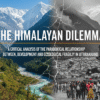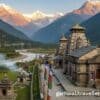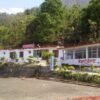Dehradun city is the most populous city of Uttarakhand and the capital of Uttarakhand state as well. So it becomes frustrating to live and travel in the city crowd, so why not visit some of the best places near Dehradun within the 100 Km range? Dehradun is surrounded by the Himalayan mountain range. It is the gateway to most of the popular hill stations.
If you are planning to visit the locations nearby Dehradun within 100 Km, then you landed on the right page. In this article, we are going to explore some best places nearby Dehradun where you can go with your friends, family, group, or as a solo traveler.
Dehradun is one of the oldest cities of Uttarakhand, where Lord Rama and his brother Lakshmana did atonement for killing the Ravana.
So let’s explore those places.
Amazing places to visit near Dehradun
1 – Mussoorie
Mussoorie also known as the Queen of Hills is one of the beautiful hill stations nearby Dehradun. Every year thousands of tourists visit Mussoorie especially during summer to get rid of the hot days of summer as well as in winter to enjoy the snowfall. It is a perfect destination for travelers and honeymoon couples.
Mussoorie is located at a distance of 34 Km from Dehradun, which makes it a perfect weekend gateway for the people of Dehradun and nearby locations. Mussoorie offers breathtaking views of the Himalayan range. This place is famous for some historic sites and India’s most expensive and popular schools.
Distance from Dehradun – 34 Km
Travel time to reach Mussoorie from Dehradun – Approx 1 hour
Best time to visit Mussoorie – September to June (during summers) and January to March (during winters)
Things to do – Trekking, Camping, Cable car ride, Hiking, Paragliding, Boating
Places to visit nearby – Kempty falls, Gun Hill, Lake Mist, Lal Tibba, Company Garden, Bhadraj Temple, Nag Devta temple
2 – Rishikesh
Rishikesh also known as the Yoga Capital of the World is one of the major pilgrimage destinations in India. There are several ancient temples and Ashrams where people from all over the world come for meditation and to learn yoga in Rishikesh.
Rishikesh is one of the best places to visit in Uttarakhand, you can visit with your friends, family, or friends group. Rishikesh is famous for Yoga, adventure sports and activities like rafting in Rishikesh, Paragliding, flying fox, jeep safari, rock climbing, camping etc.
You can also visit some famous locations such as Beetals Ashram, Bharat Mandir, etc.
Distance from Haridwar – 44 Km
Travel time to reach Rishikesh from Dehradun – Approx 1 Hour
Best time to visit Rishikesh – September to June
Things to do – River rafting, Rappelling, Bungee Jumping, Trekking, Flying fox, Cliff Jumping
Places to visit nearby – Lakshman Jhula, Triveni Ghat, Ganga Aarti, Neelkanth, Mahadev Temple, Parmarth Niketan Ashram
3 – Dhanaulti
Dhanaulti is another beautiful and famous hill station nearby Dehradun. It is located at a distance of 36 Km from Dehradun and is famous similar to Mussoorie, Chamba, Kanatak and Tehri.
This hill station is easily reachable from many cities of Uttarakhand, Delhi and Haryana. Dhanaulti is an emerging popular tourist destination and famous for oak tree forests, deodar trees and beautiful surroundings.
During winter, because of heavy snowfall, Dhanaulti is one of the best choices to visit nearby Dehradun within 100 Km.
Distance from Dehradun – 36 Km
Travel time to reach Dhanaulti from Dehradun – Approx 1 Hour 30 Minutes
Best time to visit Dhanaulti – June to September and December to March
Things to do – Trekking, Sky walking, Rappelling, Rock climbing and Camping
Must visit – Apple Orchard Resort, Adventure Park, Deogarh Fort, Surkanda Devi Kaddukhal, Eco Park
4 – Chakrata
Chakrata is another famous hill station nearby Dehradun within a 100 Km range, This hill station is located at a distance of 88 Km from Dehradun city. Chakrata is basically a cantonment hill station that is situated at an elevation of 700 feet above sea level. It is one of the most popular tourist destinations and hill stations among mountain climbers and trekkers. It is one of the popular winter destinations near Dehradun.
Chakrata was developed by Britishers, they used this place as a summer retreat for higher executives for the East India Company.
For nature lovers, bird watchers, photographers, trekkers and wildlife enthusiasts, Chakrata could be the perfect destination. Since it has been a cantonment station, some areas are restricted for Indian citizens, but for foreigners, Chakrata is prohibited.
Distance from Dehradun – 88 Km
Travel time to reach Chakrata from Dehradun – 2 Hours 30 Minutes
Best time to visit Chakrata – Throughout the year
Things to do – Skiing and Trekking
Places to visit in Chakrata – Tiger Falls, Ram Tal Horticultural Garden, Vyas Shikhar, Deoban
5 – Nag Tibba
Nag Tibba is another popular location nearby Dehradun and it is a perfect place for hiking. You are going to love the beautiful trails that offer you mesmerizing views of the Garhwal Himalayas. The route to Nag Tibba passes through Dehradun and then Mussoorie. The place is easily accessible and it is one of the popular tourist destinations for trekking trails in Uttarakhand.
Distance from Dehradun to Nag Tibba – Approx 110 Km
Travel time to reach Nag Tibba from Dehradun – 1 Hour 45 Minutes
Best time to visit Nag Tibba – September to June
Things to do in Nag Tibba – Trekking
6 – Haridwar
Haridwar is also known as Dharm Nagri and gateway to Devbhoomi Uttarakhand. This place is famous for ashrams, ghats, temples and Holy Ganga. Kumbh mela is another major attraction of Haridwar. Haridwar is another best place to visit nearby Dehradun within the 100 Km range. You can visit Haridwar at any season of the year.
Haridwar is also known for its fairs, music, folk dances and handicrafts. It is referred to as the Ganga Dwara because the holy Ganga river enters the plain here.
If you are planning to visit Haridwar and there are some best places to visit near Haridwar such as Kushwart, Kankhal, Neel Karwat, Gangadwara etc. Also, there are some spiritual places in Haridwar where you can visit.
Distance from Dehradun to Haridwar – 51 Km
Travel time to reach Haridwar from Dehradun – Approx 1 Hour
Best time to visit Haridwar – Throughout the year
Things to do in Haridwar – Spiritual Bath, Meditation, Ziplining and Yoga
Places to visit – Ganga Aarti, Mata Mansa Devi Temple, Bharat Mata Temple, Maa Chandi Devi Temple, Har Ki Pauri Ghat, Shantikunj Gayatri Parivar
So these were some places to visit near Dehradun within the 100 Km range. These destinations are perfect weekend destinations to spend quality time with your friends, family, solo, as well as with your loved ones.
1. What are some interesting places to visit near Dehradun within a 100 km radius?
Dehradun’s proximity to various attractions makes it an ideal base for exploring nearby destinations. Some interesting places within 100 km include Mussoorie, Rishikesh, Haridwar, Dhanaulti, and Chakrata.
2. How far is Mussoorie from Dehradun, and what can I expect to see there?
Mussoorie is approximately 35 km from Dehradun and is known as the “Queen of Hills.” It offers breathtaking views of the Shivalik ranges, lush green hills, and several attractions like Kempty Falls, Mall Road, and Gun Hill.
3. What makes Rishikesh a popular destination, and how can I reach there from Dehradun?
Rishikesh, located around 45 km from Dehradun, is renowned as a spiritual and adventure hub. It attracts visitors with its yoga centers, ancient temples, and thrilling activities like white-water rafting. One can easily reach Rishikesh by hiring a taxi or taking a bus.
4. Is Haridwar within 100 km of Dehradun, and what are the main attractions there?
Yes, Haridwar is approximately 54 km from Dehradun. It is a sacred city situated on the banks of the Ganges River. The main attractions in Haridwar include Har Ki Pauri, Chandi Devi Temple, Mansa Devi Temple, and Ganga Aarti.
5. Can you suggest a serene destination near Dehradun, away from the crowd?
Dhanaulti, located around 30 km from Dehradun, is a tranquil hill station offering peace and solitude. Surrounded by dense forests, it provides stunning views of the Himalayan peaks. Eco-parks, Surkanda Devi Temple, and Potato Farm are some of its attractions.
6. What is unique about Chakrata, and how can I get there from Dehradun?
Chakrata is a picturesque hill town situated about 88 km from Dehradun. It is known for its untouched beauty, dense forests, and panoramic views of the surrounding mountains. To reach Chakrata, one can hire a taxi or use public transportation.
7. Are there any waterfalls near Dehradun that can be explored within 100 km?
Yes, within 100 km from Dehradun, you can visit the beautiful Bhatta Falls and the serene Tiger Falls. Both waterfalls offer a refreshing escape and are perfect for picnics and photography.
8. Can I plan a day trip to explore these nearby attractions from Dehradun?
Absolutely! Most of the mentioned attractions can be easily covered in day trips from Dehradun. With proper planning, you can visit Mussoorie, Rishikesh, Haridwar, Dhanaulti, Chakrata, and other nearby places within a day and return to Dehradun by evening.
9. What is the best way to travel to these places within 100 km from Dehradun?
The best way to travel to these destinations is by hiring a private taxi or using public transportation like buses. Both options offer convenience and allow you to enjoy scenic beauty during the journey.



